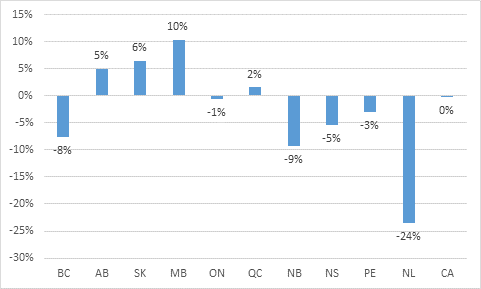If you’re a long-time reader of this blog, you’ll know that every spring I put together a little summary of provincial budgets and what they mean for higher education. A few days ago I decided to put together a slide comparing the cumulative changes in provincial funding since 2011. Here’s what it looks like, in inflation-adjusted dollars.
Figure 1: Change in real provincial government transfers to institutions, 2011-2 to 2016-17
What should immediately jump out at you (apart from the raging dumpster fire that is Newfoundland’s public fisc these days) is that while public funding for universities is flat or declining in most of the country, in the three prairie provinces increases have been the order of the day. So what’s going on out there?
The nature of the trend-bucking has differed across the three provinces. In Saskatchewan and Alberta, high energy prices kept spending buoyant at least until a couple of years ago. Since then, Alberta’s new NDP government has continued to spend, whereas Saskatchewan’s has started to retrench (but spending is still higher than it was in 2011). Manitoba’s never-too-hot, never-too-cold economy hasn’t see the big revenues fluctuations of its neighbours, but until earlier this year had a government that was prepared to engage in deficit spending in part so as to provide significant support to post-secondary education.
(You can get the gist of recent policy directions by looking at my recent provincial election analyses for Manitoba, Saskatchewan and Alberta).
So what’s in store for those three provinces now? Well, for the moment they seem headed in quite different directions. In Alberta, there were a lot of headlines about the NDP government extending its tuition freeze for a third year, but the interesting part of the announcement was that the Government simultaneously launched a review of the tuition policy with a view to a long-term funding solution. Now, given that this is a government with a heck of a deficit that isn’t going to be solved through rising oil and gas prices any time soon, you’d have to think this “review” is in fact likely to end up twelve months from now with institutions being able to move somewhat on fees. Because while the provincial government has been compensating institutions for the freeze, that still leaves income growth at around 2%. As we all know, Canadian universities start to seize up whenever the growth rate drops below 4% – so there’s a gap there that has to be plugged somehow, and higher fees are almost certainly at least part of the solution.
In Saskatchewan, fees aren’t much on the agenda but the level of government support is. Resource price falls mean that the government is running a $14 billion budget on $13 billion of revenue, so the province is talking very seriously about shrinking the size of government by 7% or so over the next two years. PSE will undoubtedly get its fair share of that cut; and that’s on top of a 7% cut over the last two years. Yet so fast was expenditure growth in the first couple of years of this decade that even this massive cut will only bring the province back to the level of spending it was at in 2011. The government speaks of looking for “transformational change” in PSE but the likelier result will be a lot of unpleasant but ultimately non-transformational corner-cutting and muddling through.
Manitoba feels like the place where fireworks are likeliest. It has a new Conservative government with a mandate to pull back at least somewhat on public finances. Post-secondary education, one of the previous NDP government’s favourite files, seems likely to get hit the worst. But the new government has some tools to mitigate these losses: tuition (currently 3rd lowest in the country) can rise, and a ghastly, wasteful post-graduation tax credit can be scrapped. The former seems more likely than the latter, but both are possible.
Meanwhile, the University of Manitoba Faculty Association, the union which sicced CAUT on its own members when an Economics department dispute over curriculum didn’t go the way some people wanted, has decided that now is the PERFECT TIME to hold a strike to support a wage demand of – are you ready for this? – 6.9% over one year.
If UMFA’s serious about this demand, it could be a long strike. And that’s not because the demand is unaffordable – in theory anything’s affordable if you cut back enough on library budgets or whatever. It’s simply politics: the new government is not going to go easy on any para-public body which appears to be out of step with the new mood of thrift. Just imagine the scene at the MB legislature if the institution were to cave on this:
U of M: “We would like some more money please. We’re kind of strapped on account of having just given the faculty a 6.9% raise”
Conservative Govt: “HAHAHAHAHAHA Come back when you learn to manage your way out of a wet paper bag”
Agreeing to such a rise would be like signing a suicide note. Unlikely to happen.
Have a good weekend.


 Tweet this post
Tweet this post
